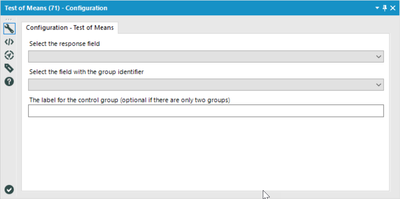 Thisarticle is part of the Tool Mastery Series, a compilation of Knowledge Base contributions to introduce diverse working examples for Designer Tools. Here we’ll delve into uses of the Test of Means Tool on our way to mastering the Alteryx Designer:
Thisarticle is part of the Tool Mastery Series, a compilation of Knowledge Base contributions to introduce diverse working examples for Designer Tools. Here we’ll delve into uses of the Test of Means Tool on our way to mastering the Alteryx Designer:A common task that analysts can run into (and a good practice when analyzing data) is to determine if the means of 2 sampled groups are significantly different. When this inquest arises, the Test of Means tool is right for you! To demonstrate how to configure this tool and how to interpret the results, a workflow has been attached. The attached workflow (v11.7 ) compares the amount of money that customers spent across different regions in the US. The Dollars_Spent field identifies the amount of money an individual spent and the Region field identifies the region that the individual resides in (NORTH, SOUTH, EAST, WEST).
First, let’s look at the interface for this tool, which is relatively simple:
- The “Select response field” allows you to choose the field containing the metric you want to compare. (Dollars_Spent in the attached workflow)
- The “Select the field with the group identifier” input allows you to choose the field that identifies the groups of interest. (Region in the attached workflow)
- The “The label for the control group” input allows you to identify the group you would like to use as the control group. (East in the attached workflow)


Choosing the control group is of interest when investigating multiple groups. Since the control group in this example is EAST, the results will compare the means of EAST vs. NORTH, EAST vs. SOUTH, and EAST vs. WEST. The following shows the results from this test:
D Output:

R Output:

From this output, we can determine whether the means of two groups represent a statistically significant difference, and which group has a higher mean.
The p-values in the output pictured above reveal that EAST and SOUTH have the only significantly different means, and the sign associated with the t-statistic (t_test & t-statistic) reveals that the mean of EAST is smaller than NORTH and WEST, but larger than SOUTH.
A note on the t-statistic:
- A negative sign means the control group has a smaller average value.
- A positive sign indicates that the control group has a larger average value.
By now, you should have expert-level proficiency with theTest of Means Tool! If you can think of a use case we left out, feel free to use the comments section below! Consider yourself a Tool Master already? Let us know atcommunity@alteryx.comif you’d like your creative tool uses to be featured in the Tool Mastery Series.
Stay tuned with our latest posts every#ToolTuesdayby following@alteryxon Twitter! If you want to master all the Designer tools, considersubscribingfor email notifications.




